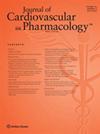紫檀素对两种心血管疾病实验模型中心肺氧化应激参数的影响:心肌梗塞和肺动脉高压。
IF 2.6
4区 医学
Q2 CARDIAC & CARDIOVASCULAR SYSTEMS
引用次数: 0
摘要
心肌梗塞(MI)和肺动脉高压(PAH)是两种常见的心血管疾病。在这两种疾病中,氧化应激都与预后恶化有关。紫檀芪(PTE)是一种抗氧化化合物,已被研究用于治疗心血管疾病。本研究旨在评估 PTE 对心肌梗死动物心脏和 PAH 动物肺部氧化应激的影响。两种模型均采用雄性 Wistar 大鼠。在心肌梗死模型中,实验组分别为假心肌梗死、心肌梗死和心肌梗死+PTE。在 PAH 模型中,实验组为对照组、PAH 组和 PAH+PTE 组。动物通过手术结扎左冠状动脉暴露于心肌梗死,或通过注射单克尿素(60 毫克/千克)暴露于 PAH。心脏损伤七天后,MI+PTE 动物接受为期 8 天的 PTE 治疗(每天 100 毫克/千克)。之后,收集心脏进行分子分析。PAH+PTE 动物在 PAH 诱导 7 天后开始接受为期 14 天的 PTE(每天 100 毫克/千克)治疗。之后,收集肺部进行生化评估。我们发现,服用 PTE 可减轻射血分数的下降,并改善梗死动物的左心室收缩末期容积。在 PAH 模型中,PTE 改善了肺动脉流量并降低了肺中的 ROS 水平。在两种心脏疾病实验模型中,服用 PTE 对氧化应激有保护作用:MI和PAH。PTE 还能改善梗死大鼠的心脏功能和 PAH 动物的肺动脉流量。本文章由计算机程序翻译,如有差异,请以英文原文为准。
EFFECTS OF PTEROSTILBENE ON HEART AND LUNG OXIDATIVE STRESS PARAMETERS IN TWO EXPERIMENTAL MODELS OF CARDIOVASCULAR DISEASE: MYOCARDIAL INFARCTION AND PULMONARY ARTERIAL HYPERTENSION.
Myocardial infarction (MI) and pulmonary artery hypertension (PAH) are two prevalent cardiovascular diseases. In both conditions, oxidative stress is associated with a worse prognosis. Pterostilbene (PTE), an antioxidant compound, has been studied as a possible therapy for cardiovascular diseases. This study aims to evaluate the effect of PTE on oxidative stress in the hearts of animals with myocardial infarction and in the lungs of animals with PAH. Male Wistar rats were used in both models. In the MI model, the experimental groups were sham, MI, and MI+PTE. In PAH model, the experimental groups were control, PAH, and PAH+PTE. Animals were exposed to MI through surgical ligation of the left coronary artery, or to PAH, by administration of monocrotaline (60 mg/kg). Seven days after undergoing cardiac injury, the MI+PTE animals were treated with PTE (100 mg/kg day) for 8 days. After this, the heart was collected for molecular analysis. The PAH+PTE animals were treated with PTE (100 mg/kg day) for 14 days, beginning 7 days after PAH induction. After this, the lungs were collected for biochemical evaluation. We found that PTE administration attenuated the decrease in ejection fraction and improved LV end-systolic volume in infarcted animals. In the PAH model, PTE improved pulmonary artery flow and decreased ROS levels in the lung. PTE administration promoted protective effects in terms of oxidative stress in two experimental models of cardiac diseases: MI and PAH. PTE also improved cardiac function in infarcted rats and pulmonary artery flow in animals with PAH.
求助全文
通过发布文献求助,成功后即可免费获取论文全文。
去求助
来源期刊
CiteScore
5.10
自引率
3.30%
发文量
367
审稿时长
1 months
期刊介绍:
Journal of Cardiovascular Pharmacology is a peer reviewed, multidisciplinary journal that publishes original articles and pertinent review articles on basic and clinical aspects of cardiovascular pharmacology. The Journal encourages submission in all aspects of cardiovascular pharmacology/medicine including, but not limited to: stroke, kidney disease, lipid disorders, diabetes, systemic and pulmonary hypertension, cancer angiogenesis, neural and hormonal control of the circulation, sepsis, neurodegenerative diseases with a vascular component, cardiac and vascular remodeling, heart failure, angina, anticoagulants/antiplatelet agents, drugs/agents that affect vascular smooth muscle, and arrhythmias.
Appropriate subjects include new drug development and evaluation, physiological and pharmacological bases of drug action, metabolism, drug interactions and side effects, application of drugs to gain novel insights into physiology or pathological conditions, clinical results with new and established agents, and novel methods. The focus is on pharmacology in its broadest applications, incorporating not only traditional approaches, but new approaches to the development of pharmacological agents and the prevention and treatment of cardiovascular diseases. Please note that JCVP does not publish work based on biological extracts of mixed and uncertain chemical composition or unknown concentration.

 求助内容:
求助内容: 应助结果提醒方式:
应助结果提醒方式:


